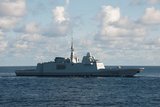L3Harris contracted for mobility research to inform autonomous systems development
The HAYSTAC contract will aid the intelligence community and US DoD in identifying subtle anomalies when developing response options for conflicts and other scenarios. (Image: L3Harris)
L3Harris has been contracted by the US Intelligence Advanced Research Projects Activity (IARPA) contract to provide technology, including modelling and simulation studies, to help characterise and predict human mobility.
This work supports the Hidden Activity Signal and Trajectory Anomaly Characterization (HAYSTAC) programme, and will lay groundwork for generating and analysing human activities that produce data captured by systems such as GPS or Bluetooth and other systems.
The goal of the research is to help inform future autonomous systems.
Related Articles
L3Harris enables better communication for British soldiers
Boeing partners with Shield AI on autonomous pilot programme
Trillium brings artificial intelligence capability to UAV imaging sensors
'Over the last four decades, L3Harris has developed and perfected its modelling and simulation analysis capabilities, which is why L3Harris is an artificial intelligence and machine learning industry leader in delivering mission-critical sense-making solutions that understand and analyse big data,' commented Ed Zoiss, president, Space and Airborne Systems, L3Harris.
Under the contract the company will use simulated information to develop models mirroring human behaviour and social networks. The solutions will aid the intelligence community and US DoD in identifying subtle anomalies when developing response options for conflicts and other scenarios.
'While bringing HAYSTAC to fruition will be a multi-year process, once it’s complete, we’ll have reframed how we look at activity in the world,' said IARPA’s HAYSTAC programme manager Dr Jack Cooper. 'And it won’t be a static concept of where things are on a map, but a dynamic one based on how they’re moving and what’s out of the ordinary.'
More from Digital Battlespace
-
![Babcock nears first customer for Nomad AI translation tool]()
Babcock nears first customer for Nomad AI translation tool
Nomad can provide militaries with real-time intelligence, saving critical time on the battlefield.
-
![AUSA 2025: Israel’s Asio Technologies to supply hundreds of improved Taurus tactical systems]()
AUSA 2025: Israel’s Asio Technologies to supply hundreds of improved Taurus tactical systems
Taurus operates alongside the Israel Defense Forces’ Orion system which supports mission management across tens of thousands of manoeuvring forces, from squad leaders to battalion commanders.
-
![AUSA 2025: Kopin pushes micro-LED plans as China moves faster]()
AUSA 2025: Kopin pushes micro-LED plans as China moves faster
The plan for the new displays follows fresh investment in Kopin’s European facilities by Theon and an order for head-up displays in fielded aircraft, with funding from the US Department of Defense.
-
![AUSA 2025: Persistent Systems to complete its largest order by year’s end]()
AUSA 2025: Persistent Systems to complete its largest order by year’s end
Persistent Systems received its largest ever single order for its MPU5 devices and other systems earlier this month and has already delivered the 50 units to the US Army’s 4th Infantry Division.
-
![Aselsan brings in dozens of companies and systems under the Steel Dome umbrella]()
Aselsan brings in dozens of companies and systems under the Steel Dome umbrella
Turkey has joined the family of countries attempting to establish a multilayered air defence system with government approval in August 2024 for the effort landed by Aselsan. Dubbed Steel Dome, the programme joins Israel’s Iron Dome, the US Golden Dome, India’s Mission Sudarshan Chakra and South Korea’s low-altitude missile defence system.
-
![DSEI 2025: MARSS unveils new agnostic multidomain C4 system]()
DSEI 2025: MARSS unveils new agnostic multidomain C4 system
MARSS’ NiDAR system has been deployed using sensors from static platforms to provide detection and protection for static sights, such as critical infrastructure, ports and military bases.




























